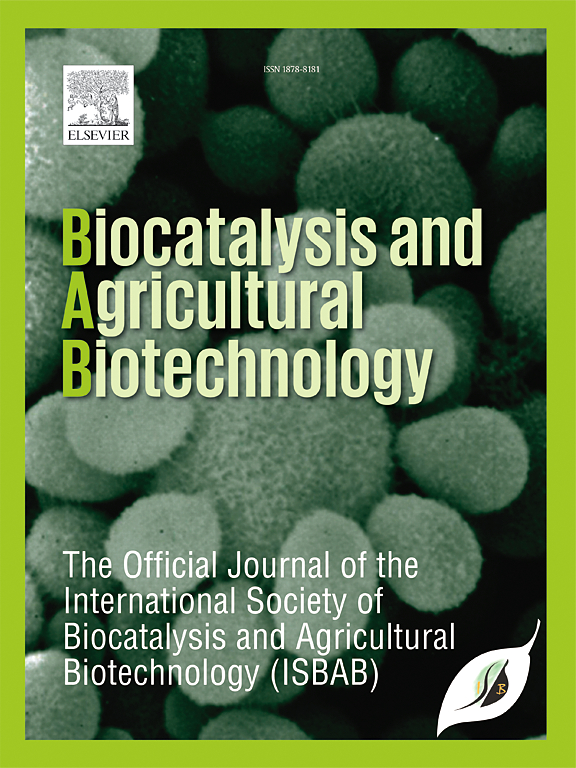水牛奶中奥德赛赖氨酸芽孢杆菌无细胞上清液的生物学潜力评价
IF 3.8
Q2 BIOTECHNOLOGY & APPLIED MICROBIOLOGY
引用次数: 0
摘要
细菌的无细胞上清含有自然产生的次级代谢物,具有抗菌、抗氧化、抗炎和抗癌的特性,在治疗领域有重要的结果。经生化和形态分析鉴定为奥德赛Lysinibacillus odysseyi VSS53 (accession number PP112153)。对分离的细菌进行的抗生素敏感性试验显示,对8种抗生素敏感,对4种抗生素中等敏感,对2种抗生素耐药。溶血和明胶酶试验的生物安全性评价表明,分离的细菌是安全的。采用UV-Vis、FT-IR和GC-MS分析无细胞上清(CFS)的化学成分。通过zeta电位和粒度分析确定了CFS的稳定性和粒径。DPPH(29.94%)、磷钼酸盐(68.63%)、FRAP(67.4%)和一氧化氮(26.23%)对抗氧化活性的抑制作用最大。抗炎活性最大抑制率为61.3%。对6株病原菌的抑菌活性进行了检测,在100 mg/mL浓度下,CFS的抑菌效果最大,在0.1 mg/mL浓度下,CFS的抑菌率最高。对MDA-MB-231细胞株的抑癌活性,IC50值为0.00705 mg/ml。经24、48 h观察,方桂蒿对CFS的毒性分析显示生长健康。总之,奥德赛乳杆菌的CFS具有治疗用途,因为它能够消除微生物和癌细胞。未来医学的进步可能会潜在地利用奥德赛L. CFS的这些有利特性。本文章由计算机程序翻译,如有差异,请以英文原文为准。
Assessment of the biological potential of cell-free supernatant of Lysinibacillus odysseyi from buffalo milk
The cell-free supernatant of bacteria contains naturally produced secondary metabolites that have antibacterial, antioxidant, anti-inflammatory, and anticancer properties, which have significant results for the therapeutic field. The isolated strain was identified as Lysinibacillus odysseyi VSS53 (accession number PP112153) through biochemical and morphological analysis. An antibiotic susceptibility test using 14 antibiotics on the isolated bacterium showed sensitivity to eight, intermediate sensitivity to four, and resistance to two antibiotics. The biosafety assessment through hemolytic and gelatinase assays indicates that the isolated bacterium has been verified as safe. The chemical composition of the cell-free supernatant (CFS) was analyzed using UV–Vis, FT-IR, and GC-MS. The stability and size of the CFS were determined through zeta potential and particle size analysis. The maximum inhibition of antioxidant activity using DPPH (29.94 %), the phosphomolybdate antioxidant assay (68.63 %), the FRAP assay (67.4 %), and the nitric oxide activity (26.23 %). Additionally, the anti-inflammatory activity maximum inhibition is 61.3 %. The antibacterial activity against six pathogenic bacterial strains was examined, with the maximum zone of inhibition observed at 100 mg/mL, and antibiofilm activity results showed the highest percentage inhibition at the 0.1 mg/ml of CFS. The anticancer activity against the MDA-MB-231 cell line, with an IC50 value of 0.00705 mg/ml. Toxicity analysis of the CFS using Artemia franciscana showed healthy growth after 24 and 48 h of observation. In conclusion, the CFS of L. odysseyi has therapeutic uses due to its ability to eliminate microorganisms and cancer cells. Future advancements in medicine could potentially harness these advantageous properties of the CFS of L. odysseyi.
求助全文
通过发布文献求助,成功后即可免费获取论文全文。
去求助
来源期刊

Biocatalysis and agricultural biotechnology
Agricultural and Biological Sciences-Agronomy and Crop Science
CiteScore
7.70
自引率
2.50%
发文量
308
审稿时长
48 days
期刊介绍:
Biocatalysis and Agricultural Biotechnology is the official journal of the International Society of Biocatalysis and Agricultural Biotechnology (ISBAB). The journal publishes high quality articles especially in the science and technology of biocatalysis, bioprocesses, agricultural biotechnology, biomedical biotechnology, and, if appropriate, from other related areas of biotechnology. The journal will publish peer-reviewed basic and applied research papers, authoritative reviews, and feature articles. The scope of the journal encompasses the research, industrial, and commercial aspects of biotechnology, including the areas of: biocatalysis; bioprocesses; food and agriculture; genetic engineering; molecular biology; healthcare and pharmaceuticals; biofuels; genomics; nanotechnology; environment and biodiversity; and bioremediation.
 求助内容:
求助内容: 应助结果提醒方式:
应助结果提醒方式:


